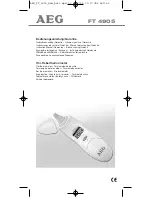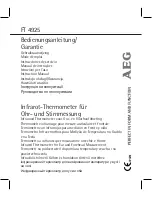
2
Fig. 4 Factory pre-set
DIL switch
settings.
7 day
OSC OFF
ON/OFF
Chrono 3
5/2 day
OSC ON
CHRONO
Chrono 6
TP75 Installation
The unit (and remote sensor when used) must be installed by a
competent electrician and the installation should conform to IEE
Wiring Regulations.
The electronics and relay switching circuits are powered by two AA
size alkaline batteries, however mains electricity control circuits
connected to this unit should be wired through a full disconnect in
accordance with BS EN60730-1, i.e. one which provides an air gap of
at least 3mm in both poles of the mains, e.g. a 13amp plug and
unswitched socket, or a switched, fused outlet with neon; either fitted
with a 2 amp (max.) fuse.
Fixing
Fig. 2 TP75 or TS2 location
1a.
TP75
Select the desired fixing position. (This should
adhere to normal room thermostat practice, see Fig. 2).
1b.
TP75A
Select the desired fixing position for the TS2
remote sensor. (This should adhere to normal room thermostat
practice, see Fig. 2). Select the desired fixing position for the
TP75A. 1·0mm² solid copper cable should be used to connect
the TP2 to the TP75A. Note that
a)
the cable length should not exceed 50 metres,
b)
to avoid electrical interference the cable should not be run
parallel in close proximity to other cables carrying mains
electricity, and where necessary the cable should cross
over mains cabling at right angles.
Fig. 3
Wallplate fixing clearances.
2.
When fixing the heating controller wallplate note that the terminals
are at the top and the vertical centre line of the heating controller
is at the right hand edge of the terminal 4 recess. Observe the
clearance required for fitting and removal, Fig. 3.
3.
Fix the wallplate to the wall or plaster box as required.
4.
Make the wiring connections for the system control circuits, (and
remote sensor when used).
5.
Surface cables can only enter from below the unit. If mounted on
a plaster box cables can enter from the rear through the aperture
in the wallplate.
6.
These models do not require an earth connection. However, an
earth terminal is provided on the wallplate to ensure earth
continuity for the connections to the heating plant. (A neutral
looping terminal is also provided.)
7.
The diagrams on the next page show typical wiring circuit's with
which the units may be used, together with terminal to terminal
wiring information for use with the WB12 Wiring Box included
with Heatshare and Heatplan Control Packs.
8.
Clear all dust and debris from the area.
9.
Before fixing the unit on to its wallplate, ensure that the four DIL
switches on the rear of the unit (see Fig. 4) have been moved to
the required settings; the choices are:-
Switch No. 1- 5/2 DAY or 7 DAY.
When the switch is in the 7 DAY position each day may be
programmed with different switching times and temperatures.
Placing the switch in the 5/2 DAY position enables Monday to
Friday to be programmed with one set of switching times and
temperatures, and Saturday and Sunday to be programmed with
a different set.
Switch No. 2 - OSC ON or OSC OFF
This is used to enable or disable the optimum start control (OSC)
function for event 1. To cater for different types of building
construction with differing fabric constants there are four start-
up curves from which to choose, (see the diagram over the
page). These curves dictate how long before event 1 the heating
equipment will be switched on. The selectable start-up durations
are 0:00, 0:30, 1:00, 1:30 or 2:00 (2 hours). (Selecting 0
effectively disables the function).
Once initiated the difference between the space temperature
and the event 1 temperature is used to generate a pre-heat
period proportional to the OSC period selected. The closer the
space temperature is to the event 1 temperature, the shorter the
pre-heat period. Refer to the earlier section on Optimum Start
Control for more detail.
It is recommended that the initial setting of the OSC is 30
minutes. See the section on post-commissioning.
Switch No. 3 - CHRONO or ON/OFF
With this switch set to ON/OFF the TP75 will act as a conventional
room thermostat, switching the heating plant to maintain the
programmed temperature. When set to CHRONO the control
function selected by switch No. 4 is enabled.
IMPORTANT
. For systems with motorised zone valves ON/OFF
mode is recommended.
Switch No. 4 - Chrono 6 or Chrono 3
This switch configures the TP75 to control different forms of
heating system, typically as follows:
Use Chrono 3 for high thermal inertia systems, e.g. floor
standing cast iron boilers.
Use Chrono 6 for low thermal inertia systems, e.g. low water
content boilers and combi. boilers.
See the earlier section on Chrono-proportional Control for more
detail.
10.
Position the slots in the top surface of the module over the lugs
at the top of the wallplate, and hinge downwards until the module
is pressed fully against the wallplate. Tighten the two screws
from below to fix the module to the wallplate.
11.
Before setting the programmes the unit and circuits should be
checked. Refer to the following Commissioning Instructions.
30mm
minimum
Wall or Plaster box
mounting holes
Aperture for rear
cable entry
Knockouts for
bottom cable
entry
Outline of unit
Terminals
C/L
N &
looping
terminals
Clearance for
screwdriver
access






















